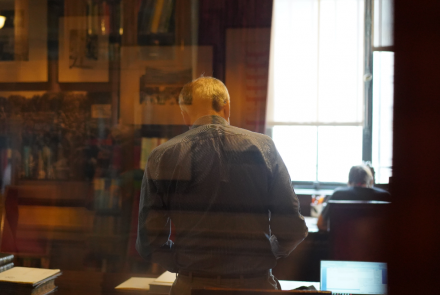
Photo by Jouwan Wang on Unsplash
Public messaging, trust and COVID-19: some pointers for policymakers
Mixed messages, blame shifting, and political point-scoring won’t help us. What we need are clear communications and a whole-of-society effort, Matthew Sussex writes.
Globally, COVID-19 is revealing the best about our societies and governments. But it is also revealing the worst. At this time of extreme crisis, it is absolutely crucial for Australia’s governments to communicate effectively with a public that has become conditioned to be sceptical about spin. One recent poll found only 35 per cent of Australians trusted the media on COVID-19, and only about half felt well informed by government.
This must turn around fast, or the virus will simply do it for us as our hospitals are overwhelmed.
The Federal government’s public messaging on COVID-19 has been shambolic and confusing. A couple of weeks ago I wrote a piece for Inside Story that urged a clear and consistent messaging campaign to inform Australians and give them confidence in the government’s leadership. We are still waiting for such a campaign.
Above all – and this seems to have been only recently realised – any effort to flatten Australia’s epidemic curve is doomed to fail unless Australians change their behaviour fundamentally. Literally every hour counts. On the flipside, so does every unnecessary social interaction. This must be a whole-of-society effort, not just a whole-of-government one.
That may be starting to change, but the wheels of government are still moving far too slowly on public messaging. If there is one lesson from COVID-19 it is that graduated incrementalism is a poor predictor of success. What matters is speed, decisiveness and risking overreaction in preference to decision paralysis with a ‘wait and see’ attitude.
That’s why we recently saw the states effectively override a federal government response that was seen as moving far too slowly. Under any other circumstances it would be extraordinary. But it is fast becoming the new normal.
How can policymakers and politicians better communicate with a mistrustful electorate? Here are 10 steps that might help.
Don’t obfuscate. It makes you look shifty. If you don’t know the answer, say so. And then say what you are doing to find the answer, and when you will communicate it. If the answer is contested, say clearly why you have adopted a particular course of action. Taking refuge in long-winded answers doesn’t enhance public trust. On the contrary, it diminishes it.
Don’t lie. The prime example here was Stuart Robert’s atrocious decision to claim that the Centrelink website had crashed due to a cyber attack, rather than the truth: that it collapsed under the weight of the newly unemployed. This was an insult to the thousands of people who queued for hours outside Centrelink offices, and a disgracefully tone-deaf exercise in self-preservation.
Political capital is worthless for the foreseeable future. That’s because political capital relies on division. Instead social capital is now king. We need to bring all Australians on board, not voting coalitions. This will be a hard lesson for those in government who have become conditioned to trading in spin and selective omission of the facts.
One specific constituency – younger people – need to be better persuaded that choices have consequences. That’s a difficult undertaking for a group that is naturally distrustful of authority, and also may feel bulletproof. To cut through, policymakers need to do the following:
– Recognise that younger people typically view government messaging with derision, especially since it is generally not aimed at them.
– If government messaging isn’t working, it should not take the lead. Instead it should empower civil society champions to convey the message to younger people, in ways they understand and relate to. Perversely, we may finally have found a useful function for ‘social influencers’.
Adjust policy swiftly to accommodate weaknesses rather than burying them. For instance, if we have a shortage of testing kits and contact tracing is struggling, we need harsher social controls. That also makes it necessary to communicate what we intend to do to rectify areas our shortcomings.
The public will not tolerate buck-passing and ‘problems of federalism’. The blame-shifting by the New South Wales state government and the federal government over who was responsible for letting thousands of potentially infected people off the Ruby Princess was unnecessary and undermined public trust. So too was the obvious tension between some states and the federal government over shutdowns of non-essential services.
Politicians must lead by example. Encouraging people to go to the football one week and then hectoring them about going to the beach the next is a regrettable double standard.
People need to see plans of action and have confidence in them. They do not react well to processes, concepts, and vague language. Nor is it the time to water down messaging with comforting slogans. This means using language carefully and deliberately. A few examples:
– ‘Stay home and save lives’ is much more direct and effective than ‘Practice social distancing’.
– ‘Groups of people put everyone at risk’ is more direct and effective than ‘Observe four square metres of separation in indoor gatherings’.
– References to ‘Stage One’ social distancing controls, with the admission that there was no understanding of what ‘Stage Two’ might be, imply rudderless leadership. A model like New Zealand’s simple four-stage plan should be adapted and shared with the public.
People need better information about cases and locations so they can assess risk. We should immediately look at adapting tools like Singapore’s app for contact tracing, which has recently been made available internationally.
Visible solidarity across the political spectrum is vital. If the government is not comfortable inviting the Opposition Leader into the National Cabinet, it should at least hold joint press conferences featuring Scott Morrison and Anthony Albanese to reinforce messaging.
The gold standard responses to COVID-19 so far are all in Asia. While China’s approach can’t be replicated in Australia, the examples of Taiwan, South Korea, Hong Kong and Singapore do share some significant commonalities, and we can follow them. Their communications have been honest and clear. When policies needed to shift – which happens frequently given the nature of the threat – the reasons for doing so have been spelled out.
Above all, if we are to mitigate the awful effects of this virus, we need to do so together. That’s because an effective response relies on a nation’s most important resource: its people.
Updated: 18 July 2024/Responsible Officer: Crawford Engagement/Page Contact: CAP Web Team












